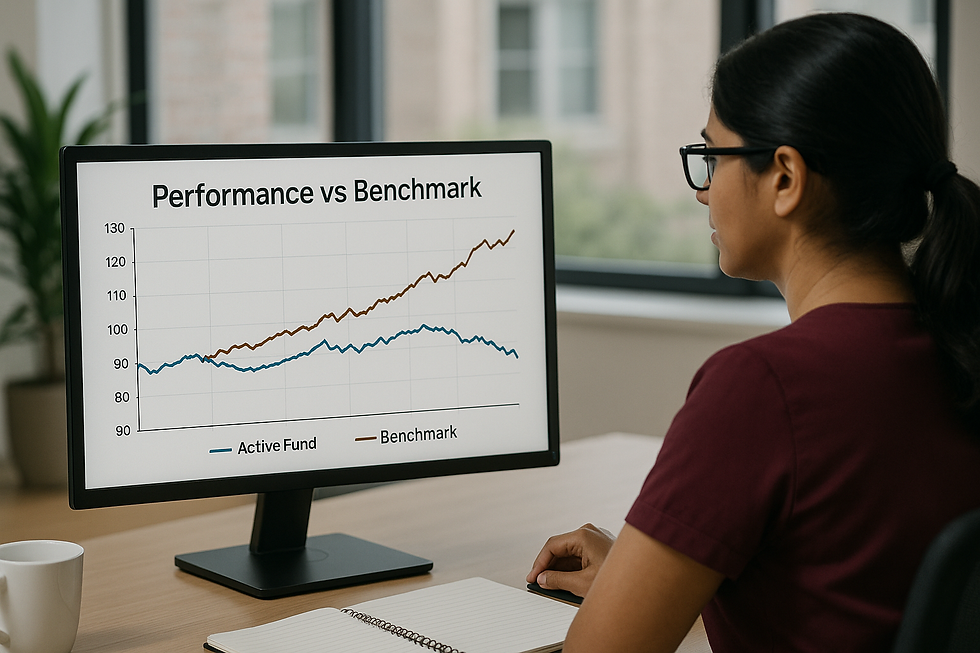Active vs Passive Funds – Settling the Debate
- Wealth Beacon Team

- Jul 22
- 4 min read
Updated: Jul 24
The debate between active and passive funds has been around for decades. In 2007, Warren Buffett famously made a million-dollar bet with a hedge fund manager. His wager? That a low-cost S&P 500 index fund would outperform a carefully selected portfolio of hedge funds over a 10-year period. Buffett’s rationale was simple: high fees eat into returns, and beating the market is harder than it looks.
Guess what? Buffett won that bet, and convincingly so.
What does this mean for Indian investors? Should we lean towards active management or stick with low-cost passive funds? In this blog, we explore this debate in the Indian context. And for those who enjoy a deeper dive, we’ll close with a mathematical insight that may change how you think about portfolio performance.

Active Funds: Trying to Beat the Market
Active funds are run by professional managers who aim to outperform a benchmark index like the Nifty 50 or BSE 200. They do this by carefully selecting stocks, deciding how much to allocate to each, and adjusting positions as market conditions change.
Because of the skill and effort involved, active funds tend to charge higher fees. These fees are only justified if the manager consistently delivers returns greater than the benchmark plus costs. That’s a tall order especially as markets become more efficient and harder to beat.
Passive Funds: Owning the Market
Passive funds, on the other hand, don’t try to beat the market - they try to become it. They follow a rules-based approach, usually tracking a free-float market capitalization-weighted index. That’s a fancy way of saying they buy the stocks that make up an index in the same proportion.
The result? Low fee, low transaction costs and no manager bias.
Popular passive funds in India include Nifty 50, Nifty Next 50, Nifty Midcap 150, Nifty 500 and Nasdaq 100 index funds. Here’s a mind-blowing fact: free-float market-cap indices represent the average of all investors' portfolio in the market. We’ll revisit the importance of this in the final section.
The Efficient Market Hypothesis (EMH)
The Efficient Market Hypothesis is a foundational theory in finance. It says that all publicly available information is already reflected in stock prices. So, unless a fund manager has access to superior information, they will struggle to consistently outperform the market.
While even Eugene Fama, the father of EMH, acknowledged that it’s a theoretical model (not a perfect real-world rule), the data largely backs it up - especially in developed markets.
The Data: How Do Indian Funds Stack Up?
In the US, less than 10% of active funds beat their benchmark over a 10-year period, according to the SPIVA (S&P Indices Versus Active) report.
India presents a slightly different picture - reflecting the fact that Indian Markets may still not be as efficient as the US. Here’s how Indian equity funds performed with respect to their benchmarks from June 2020 to June 2025:
Fund Category | Outperforming | Underperforming | Percentage Outperforming |
Large Cap | 15 | 12 | 55% |
Mid Cap | 8 | 16 | 33% |
Small Cap | 7 | 14 | 33% |
Flexi Cap | 11 | 13 | 45% |
Total | 41 | 55 | 42.7% |
Only in the Large Cap category did more than half the funds outperform their benchmarks—and even that’s debatable. Many so-called large-cap funds invest up to 20% in mid and small cap stocks, which benefited from a strong bull market in that segment.
Our Recommendation
If you don’t want to dive into the complexities of fund analysis – or just don’t have the time - stick with low-cost index funds. They’re efficient, transparent, and likely to beat a majority of the actively managed alternatives over time.
But if you’re chasing alpha (outperformance), then:
Be prepared to put in the work—learning to analyze fund performance, portfolio strategy, manager track records, and more.
Or, rely on an expert financial advisor who does this for a living.
Malcolm Gladwell popularized the “10,000-hour rule” in Outliers – the idea that expertise requires serious commitment. If you're not putting in those hours, your best bet may still be the index.
A Mathematical Look (For the Curious Reader)
Let’s wrap with a more technical lens on why index funds outperform the majority of active portfolios.
Assume logarithmic market returns are normally distributed, a standard assumption in finance. Black-Scholes wouldn’t exist without this assumption.
Let R ~ Normal(μ, σ²) be the return distribution over 1 year.
Then over N years, Rtotal ~ Normal(N * μ, N * σ²),
and
Portfolio Value ~ LogNormal(N * μ, N * σ²)
Here’s what this means in plain English:
The log-normal distribution is skewed—it has a long tail on the right.
As a result, the mean return is higher than the median.
The mean represents the average of all investor portfolios - this is what index funds replicate.
The median is the performance of the median investor (who’s squarely in the middle if investors were ranked by performance).

Conclusion? If the average return (index) is higher than the return of the median fund, it implies that more than 50% of funds underperform the index.
Final Word
The active vs passive debate doesn’t need to be settled with emotion or marketing slogans. The data, theory, and math point in the same direction:
Passive funds win by default, because they reflect the average and charge less.
Active funds must win by skill, but only a few consistently do. In Wealth Beacon’s analysis of over 3000 active mutual funds in India, only about 100 met the criteria for being investible.
As an investor, the choice boils down to this: Are you confident in your ability to beat the market? If not, get a professional advisor or settle the debate by doing what Buffett would do - bet on the index.




Comments